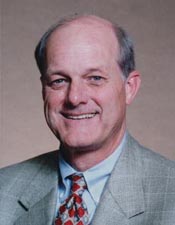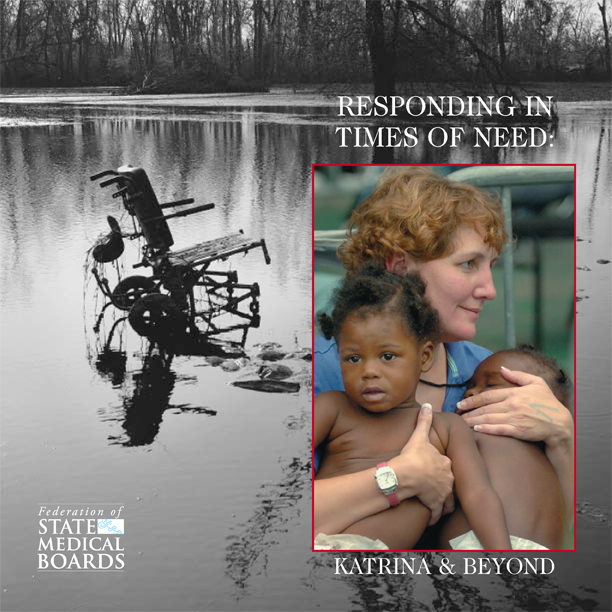Computerization efforts by FSMB reflected the organization's commitment to becoming an informational and data resource. During this period the Federation launched its Legislative and Regulatory Exchange. This publication evolved into a significant publication during the 1980's and 1990's. A second major initiative involved the development of a Self-Assessment Instrument (SAI) for state medical boards. This complemented the model policy, Elements of a Modern State Medical Board, by providing boards with an objective instrument for measuring their own performance longitudinally and in comparison to other boards of similar size and structure.
 James R. Winn continued the work of the Galusha with the addition of three major programs during his tenure as chief executive (1989-2001). Reviewing the credentials and qualifications of a physician to assure minimum standards as part of the licensure process still remained a critical activity of boards. The Federation Credentials Verification Service (FCVS) traces its origins to a 1993 conference on licensure endorsement and a recommendation from the Federation Ad Hoc Committee on Licensure by Endorsement in May 1993. Established in 1995, the FCVS provides a central repository for primary source verified core physician credentials (i.e., identity, medical school, etc). The physician can have his/her 'profile' sent to a state medical board to expedite the licensure process. The Utah Physicians Licensing Board and Oklahoma State Board of Medical Licensure and Supervision were the first accepting boards and the State Medical Board of Ohio became the first requiring board. Today, FCVS has credentialed nearly 130,000 physicians.
James R. Winn continued the work of the Galusha with the addition of three major programs during his tenure as chief executive (1989-2001). Reviewing the credentials and qualifications of a physician to assure minimum standards as part of the licensure process still remained a critical activity of boards. The Federation Credentials Verification Service (FCVS) traces its origins to a 1993 conference on licensure endorsement and a recommendation from the Federation Ad Hoc Committee on Licensure by Endorsement in May 1993. Established in 1995, the FCVS provides a central repository for primary source verified core physician credentials (i.e., identity, medical school, etc). The physician can have his/her 'profile' sent to a state medical board to expedite the licensure process. The Utah Physicians Licensing Board and Oklahoma State Board of Medical Licensure and Supervision were the first accepting boards and the State Medical Board of Ohio became the first requiring board. Today, FCVS has credentialed nearly 130,000 physicians.
A second major initiative under Winn's tenure was the All-Licensed Physician (ALP) project. The Federation deemed the absence of licensure information on individual physicians in its database as a major omission to be addressed immediately. Obtaining this information would allow the Federation to proactively alert each state board in which a physician held a license in the event of a disciplinary action taken by the board in another state. It would also allow the Federation to assist state boards with license verifications and disciplinary checks in the event of an emergency.
The first files containing individual boards' roster of licensees arrived in mid-1998. By the end of 2000, all boards had forwarded at least one complete file of all their licensees. Equally important, several dozen boards were now forwarding updated licensure files on a regular basis to supplement the initial roster of all their licensees. This meant that the ALP could support the Federation's board action data bank by sending out an alert, within 24 hours, to all state boards where a physician was licensed after receipt of a board action in any one of those states.
 Hurricane Katrina tested the system's ability to provide coordinated response. The Federation assisted the Louisiana board by serving as its "display agent," effectively acting as a temporary surrogate for the board. The Federation assisted the Texas and Mississippi boards by checking disciplinary history and credentials on hundreds of physicians as they worked to accommodate both early responders hoping to assist and displaced physicians seeking to practice.
Hurricane Katrina tested the system's ability to provide coordinated response. The Federation assisted the Louisiana board by serving as its "display agent," effectively acting as a temporary surrogate for the board. The Federation assisted the Texas and Mississippi boards by checking disciplinary history and credentials on hundreds of physicians as they worked to accommodate both early responders hoping to assist and displaced physicians seeking to practice.
Another milestone under Winn's tenure was the introduction of the United States Medical Licensing Examination (USMLE). In the mid-1980's, the existence of multiple licensing examination pathways came under scrutiny from examinees and legislators in California, Florida and New York.
The outcome of this churning was a return to the long-held desire by many within the medical regulatory community for a more uniform examination pathway. In 1988, a multi-organization task force proposed a single examination pathway which the Federation and National Board of Medical Examiners (NBME) embraced. The two organizations partnered to create the USMLE and phased out their FLEX and NBME Parts exams. The USMLE has since administered more than 1.5 million Step administrations. It has steadily advanced the scope of assessment for medical licensure with the incorporation of new testing formats during the transition to computer-based testing in 1999 and the introduction of a clinical assessment component for Step 2 in 2004. Even now, the program is engaged in a strategic enhancement to its assessment.
The Federation has also supported state medical boards through advocacy, legislative analysis and policy development. This growing emphasis on policy proved timely as the state medical board community entered a consumer-focused era stressing accountability and transparency. Winn recognized the potential of the Federation's special committees to foster greater uniformity in policy and standards in our state-based system for medical regulation. Looking back at the extensive policy work undertaken by the Federation in the 1990's, much of it fell primarily into three categories: licensure; professionalism; and the practice of medicine. In the area of licensure, two of the more important special committee initiatives centered upon licensure by endorsement and uniform standards and procedures.
Professionalism and ethics represent another area of extensive Federation policy work in the 1990's. The Federation turned its attention to this area several times with a joint 1995 Federation and AMA report on Ethics and Quality of Care and later with the Report on Professional Conduct and Ethics;
A Model Act to Regulate the Practice of Medicine Across State Lines; Model Guidelines for the Appropriate Use of the Internet in Medical Practice; Ad Hoc Committee on Physician Impairment and the Report on Sexual Boundary Issues.
The final area of major policy development by the Federation and its member boards beginning in the 1990s centered upon the practice of medicine. Policy work in this included Model Guidelines for the Use of Complementary and Alternative Therapies in Medical Practice; the Report of the Special Committee on Outpatient (Office-Based) Surgery and Model Guidelines for the Use of Controlled Substances for the Treatment of Pain. The Federation and its Foundation for Education and Research later built upon the latter policy with the publication of Responsible Opioid Prescribing.
The last decades of the 20th century saw transformative changes at the Federation. The flagship services to state medical boards commonly associated with the Federation—the USMLE, FCVS, Physician Data Center—were all established or significantly enhanced during this time period. The organization grew from little more than a dozen staff to more than 100 permanent, full-time staff members as a direct result of the USMLE and FCVS programs. The Federation's Fort Worth offices lacked sufficient space to accommodate growth so in 1995 the organization purchased its current two building complex near the Dallas-Fort Worth airport. Services once wholly or primarily paper-driven have moved to electronic, web-based platforms. Educational programming once offered strictly as in-person meetings now began utilizing internet-based platforms to reach the broadest possible state board audience.
 The Federation had become a national organization whose long history and major initiatives secured their position as the voice of the state medical board community. Nowhere was this more apparent than in the Federation's policy work. While neither the resolutions nor reports adopted by the Federation's House of Delegates were binding upon individual state medical boards, they represented a collective consensus and commitment to key principles and practices among the broader state board community.
The Federation had become a national organization whose long history and major initiatives secured their position as the voice of the state medical board community. Nowhere was this more apparent than in the Federation's policy work. While neither the resolutions nor reports adopted by the Federation's House of Delegates were binding upon individual state medical boards, they represented a collective consensus and commitment to key principles and practices among the broader state board community.

